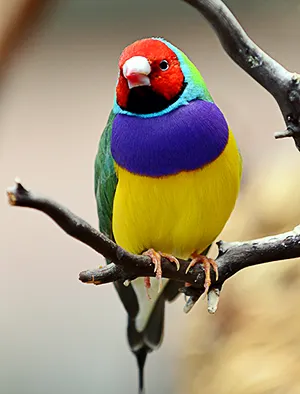Gouldian Finch Rainbow Finch

Gouldian Finch Description
Gouldian Finches (Erythrura gouldiae) are beautifully coloured grass finches that were once found by the millions throughout the northern parts of Australia. Only about 2,500 of these spectacular birds survive in the wild today. Other names for this bird are Rainbow Finch, Lady Gouldian Finch, Purple Breasted Finch and Gouldian Grass-finch.
Gouldian finches are about 13cm in length, have green backs, cyan coloured necks, purple breast feathers, and yellow bellies. While there is only one species of this bird, there are three variations to the feathers on their faces. These variations are referred to as black-headed (75% of the population), a red-headed (25%), and the very rare yellow-headed.
Males are more brightly coloured than females. Young gouldian finches are rather drab, having pale green backs, grey heads and necks, and pale brown undersides.
Habitat Where Do the Gouldian Finches Live?
Once found throughout northern Australia, the last surviving flocks of gouldian finches live in a few remote locations in the Kimberley in Western Australia, and the northern parts of the Northern Territory and Queensland in Australia.
These birds live close to water in the tropical savannah and woodlands with under-story of grasses. They usually live in a small local habitat of about 40 square kilometres; only moving when food or water become scarce.
Diet What do Gouldian Finches Eat?
Gouldian finches feed on both ripe and partially-ripe grass seeds. They forage on the ground or pluck seeds off grass stalks. They require plenty of fresh water.
There are some claims that gouldian finches eat insects in the wild but there is no conclusive evidence of this.
Reproduction Gouldian Finch Babies
Gouldian finches nest in tree hollows and in holes in termite nests close to a source of water. They are not very good nest builders, usually not bothering to build any sort of nest bed at all. Several pairs of birds may share the same nest. These birds make raise between two to three broods each year.
The male bird courts the females by ruffling his brightly coloured feathers and dancing in front of the female. After mating the female lays a clutch of 4 to 8 eggs. Both parents help incubate the eggs during the day. Only the female sits on the egg during the night. The hatchings appear in 12 to 14 days and leave the nest when they are about 20 days old. They are fully independent when they are about 40 days old.
The young birds start to moult at around 9 weeks and acquire their beautiful adult plumage by the time they are 6 months old. Gouldian Finches live to about 5 years of age in the wild.
Threats and Predators What Kills Gouldian Finches?
The major threats to the gouldian finch are bushfires that flare up during the dry season. These fires destroy grasses and their seeds and also burn down trees thereby depriving these birds of their nesting tree hollows. Other threats include, human introduced, grazing animals such as cattle, sheep, feral camels and rabbits which eat and destroy grasses that the gouldian finch is so dependent on for food. In the past these exotic birds were also captured by humans for sale as pets. (The capture of gouldian finches was banned in the 1980s).
Conservation Status – Endangered Is the Gouldian Finch Endangered?
Near Extinct in the Wild
Gouldian finches are severely threatened in the wild. It is feared that they may well become extinct within a few years. There has been a dramatic decline in these birds in the last century. The reason for this decline is not fully understood. Conservations efforts have been underway for many years but these have proven ineffective so far.
Saved by the Pet Industry
Because of its brilliant colours the gouldian finch is very popular as a pet. As a result, many are breed in captivity by the pet industry and the animal is expected to survive.
All Rights Reserved. (Last Updated: May 31, 2025)